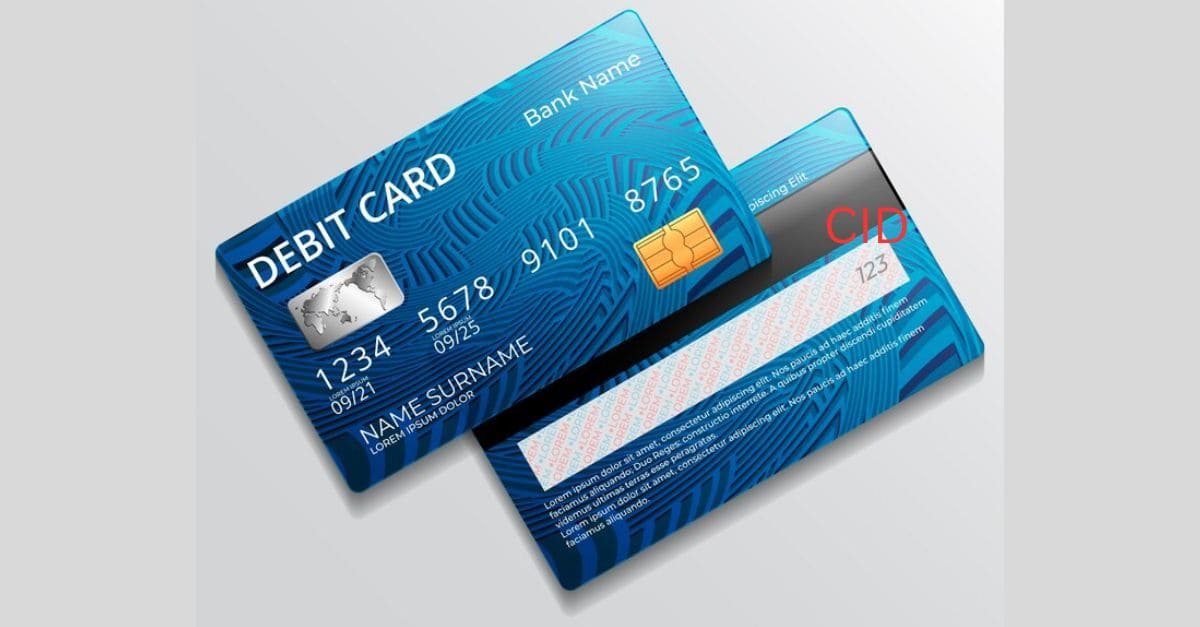
Are you familiar with your credit card identification number (CID)? The CID, also known as the card verification value (CVV) or card verification code (CVC), is a three-digit number on most credit cards’ backs. It is an extra protection against fraud when making online or phone purchases.
By understanding the importance of the CID and how it works, you can better protect yourself from unauthorized transactions and potential identity theft. This guide will provide detailed insights into the CID’s purpose, how it differs from other security features, and tips for keeping it safe.
Don’t let the CID mystify you any longer. Read this comprehensive guide and empower yourself with the knowledge you need to navigate the world of credit card security confidently.
Table of Contents
What is a Card Identification Number (CID)?
The Card Identification Number (CID), also referred to as the card verification value (CVV) or card verification code (CVC), is a three-digit number that provides an additional layer of security for credit card transactions. It is typically found on the back of most credit cards, although some cards may have it on the front.
The CID is not embossed on the card, which means simple imprints cannot easily replicate it. This makes it more difficult for fraudsters to use stolen credit card information for unauthorized purchases. The CID serves as a unique identifier for each card, ensuring that the person making the transaction possesses the physical card.
To enhance security, the CID is not stored in the card’s magnetic stripe or chip. This means that even if a fraudster gains access to the card’s magnetic stripe or chip data, they would not have access to the CID. This adds an extra layer of protection for both online and offline transactions.
Understanding the purpose and significance of the CID is essential for safeguarding your credit card information and preventing fraudulent activities. Now that we have a basic understanding of CID let’s explore its importance in credit card security.
Importance of the CID for credit card security
The CID is crucial in credit card security, safeguarding against unauthorized transactions. It serves as a verification tool for online and phone purchases, ensuring that the person making the transaction possesses the physical card.
When you make an online or phone purchase, you must usually provide the CID along with your credit card number, expiration date, and billing address. This information adds an extra layer of security by confirming that the person making the purchase has the physical card in their possession.
The CID also helps protect against potential identity theft. If a fraudster gains access to your credit card number, they still need the CID to complete a transaction. Without it, their attempts to use your credit card information would be futile.
By incorporating the CID into the transaction process, credit card companies and merchants can reduce the risk of fraudulent activities and provide a safer environment for consumers to purchase. However, the CID is just one part of a multi-layered security system. It should always be used with other security measures to ensure maximum protection.
Where to find the CID on different types of credit cards
The location of the CID on credit cards can vary depending on the card issuer and the card type. You will most commonly find the CID on the back of the card, typically on the right-hand side of the signature strip.
The CID is a three-digit number at the end of the signature strip for Visa, Mastercard, and Discover cards. It is usually printed in a separate box and is slightly raised, making it easier to identify by touch.
On American Express cards, the CID is a four-digit number on the front above the card number. It is printed flat on the card, just like the other card details.
It’s important to note that the CID should not be confused with the PIN (Personal Identification Number) used for ATM transactions. The CID is designed for online and phone purchases, while the PIN is used for face-to-face transactions and ATM withdrawals.
Now that we know where to find the CID on different types of credit cards let’s delve into how the CID differs from other card security features.
How the CID differs from other card security features
The CID is just one of the security features incorporated into credit cards to protect against fraud and unauthorized transactions. It differs from other security features in terms of its purpose and the information it provides.
While the CID verifies that the person making the transaction has the physical card in their possession, the card’s magnetic stripe or chip contains the cardholder’s account information, such as the credit card number and expiration date. These details are necessary for the transaction to be processed, but they alone do not provide sufficient security.
The CID adds an extra layer of security by requiring the cardholder to provide additional information not stored on the magnetic stripe or chip. This helps prevent unauthorized individuals from using stolen credit card information for fraud.
In contrast, the PIN is a security feature for face-to-face transactions and ATM withdrawals. It is a numerical code that the cardholder enters to verify their identity. The PIN is usually associated with debit cards, which require the cardholder to have funds in their bank account.
While the CID and PIN serve different purposes, they contribute to overall credit card security. By combining these multiple layers of protection, credit card companies can provide a more robust system for protecting cardholder information and preventing fraud.
Understanding the different types of CID (CVV, CVC, CVV2)
Different names know the CID, depending on the card issuer. The most common variations are CVV (Card Verification Value) and CVC (Card Verification Code). American Express uses the term CVV2.
CVV and CVC are interchangeable terms that refer to the three-digit number on the back of most credit cards. They are used primarily for online and phone transactions to verify that the cardholder possesses the physical card.
CVV2, on the other hand, is the four-digit number printed on the front of American Express cards. It serves the same purpose as CVV and CVC, providing an extra layer of security for online and phone purchases.
The specific name used for the CID may vary depending on the card issuer, but their purpose remains the same. They are all designed to prevent fraud and protect the cardholder from unauthorized transactions.
It’s important to note that the CID should never be shared with anyone, including merchants or customer service representatives. It should only be used to complete transactions. Now that we understand the different types of CID let’s explore how they are used in online and offline transactions.
How the CID is used in online and offline transactions
The CID is vital to credit card security, especially regarding online and phone transactions. When purchasing online or over the phone, you will typically be asked to provide the CID along with your credit card number, expiration date, and billing address.
This additional information helps verify that the person making the transaction is in possession of the physical card. It also deters fraudsters who have access to stolen credit card information but lack the CID.
The CID is usually entered into a secure payment gateway or payment page during checkout for online transactions. The merchant does not store it, further enhancing security. The card issuer verifies the CID, which confirms whether it matches the cardholder’s information on file.
The CID is not typically required in face-to-face transactions, such as at a physical store or restaurant. Instead, depending on the type of card and the payment method being used, the cardholder may be asked to provide their signature or enter their PIN.
Now that we understand how the CID is used in different types of transactions let’s move on to some valuable tips for protecting your CID from fraud and theft.
Tips for protecting your CID from fraud and theft
Protecting your CID is crucial for maintaining the security of your credit card transactions. By following these tips, you can minimize the risk of fraud and unauthorized use of your credit card:
- Keep your credit card safe: Store your credit cards in a secure location, such as a wallet or a locked drawer. Avoid leaving them unattended or in easily accessible places.
- Memorize your CID: Instead of writing down your CID, try to memorize it. This way, you won’t have to rely on physical records that could be lost or stolen.
- Avoid sharing your CID: Never share your CID with anyone, including merchants or customer service representatives. Legitimate organizations will not ask for your CID, as it is meant to be kept confidential.
- Be cautious with online transactions: When making online purchases, ensure that the website is secure and reputable. Look for the padlock symbol in the browser address bar and check for “https” in the URL, indicating a secure connection.
- Monitor your credit card statements: Regularly review your credit card statements for any unauthorized transactions. Report any suspicious activity to your credit card issuer immediately.
- Report lost or stolen cards promptly: If your credit card is lost or stolen, contact your credit card issuer immediately to have the card canceled and a new one issued. This will help prevent unauthorized credit card use and protect your CID.
By following these tips, you can significantly reduce the risk of CID-related fraud and ensure the security of your credit card transactions. Now, let’s address some frequently asked questions about the CID.
Recommended Article: Can you add a Credit Card to the Cash App?
Common misconceptions about the CID
Misconception 1: The CID is the same as the PIN.
The CID and PIN are two different security features with distinct purposes. The CID is used for online and phone transactions, while the PIN is mainly for face-to-face transactions and ATM withdrawals.
Misconception 2: The CID is stored in the magnetic stripe or chip.
Unlike other card details, the CID is not stored in the magnetic stripe or chip of the credit card. This adds a layer of security, as fraudsters cannot retrieve the CID from these sources.
Misconception 3: The CID is not necessary for secure transactions.
The CID is a critical security feature that helps protect against fraud and unauthorized transactions. It verifies that the person making the transaction possesses the physical card, reducing the risk of fraudulent activities.
Misconception 4: The CID is visible to merchants.
Merchants should never have access to your CID. Legitimate organizations understand the importance of safeguarding this information and will not ask for it.
To ensure the security of your credit card transactions, it’s essential to have a clear understanding of the CID’s purpose and functionality. You can make informed decisions and stay protected by dispelling these common misconceptions.
Conclusion
In conclusion, a card identification number (CID) is crucial in credit card security. It provides additional protection against fraud and unauthorized transactions. By understanding the purpose and significance of the CID, you can better protect yourself from potential identity theft and ensure secure credit card transactions.
FAQs: What is CID on credit card?
Can I use my credit card without the CID?
In most cases, the CID is required for online and phone transactions. However, some merchants may not ask for the CID, especially for small purchases. It’s important to note that not all transactions require the CID, but its absence may increase the risk of unauthorized use.
Is it safe to enter my CID online?
Entering your CID online is generally safe as long as you are using a reputable and secure website. Look for the padlock symbol in the browser address bar and ensure that the website’s URL starts with “https.” This indicates that your connection is encrypted and secure.
Can someone steal my CID if they can access my credit card number?
While having access to your credit card number is concerning, the CID adds an extra layer of security. Without the CID, it becomes significantly more difficult for fraudsters to complete transactions using your credit card information.
Can I change my CID?
Unfortunately, you cannot change your CID. The CID is a unique identifier associated with your credit card and cannot be modified or personalized.
What should I do if I suspect fraudulent activity on my credit card?
If you suspect fraudulent activity on your credit card, contact your credit card issuer immediately. They will guide you through the necessary steps to protect your account, investigate the suspicious transactions, and issue a new card if required.






